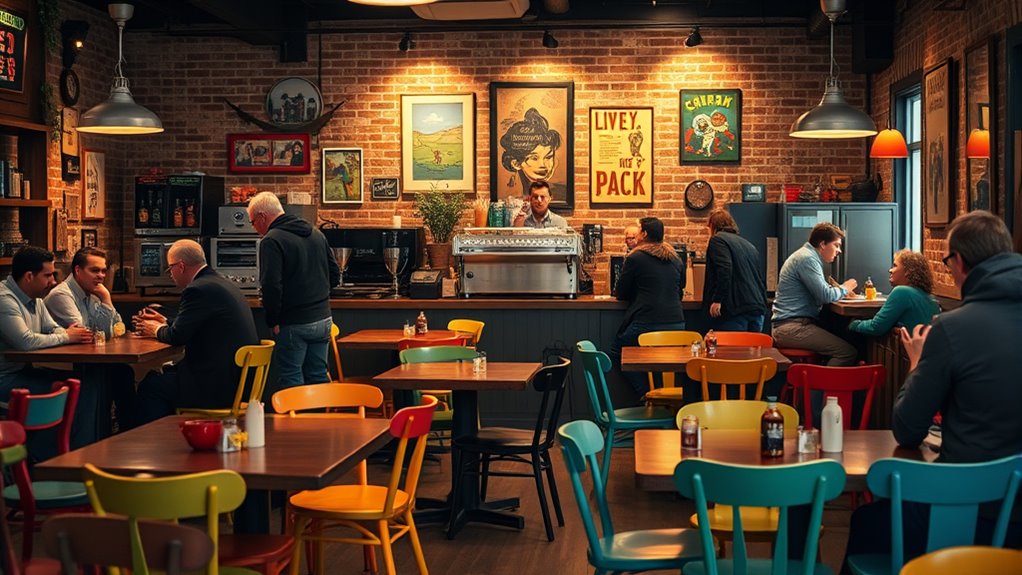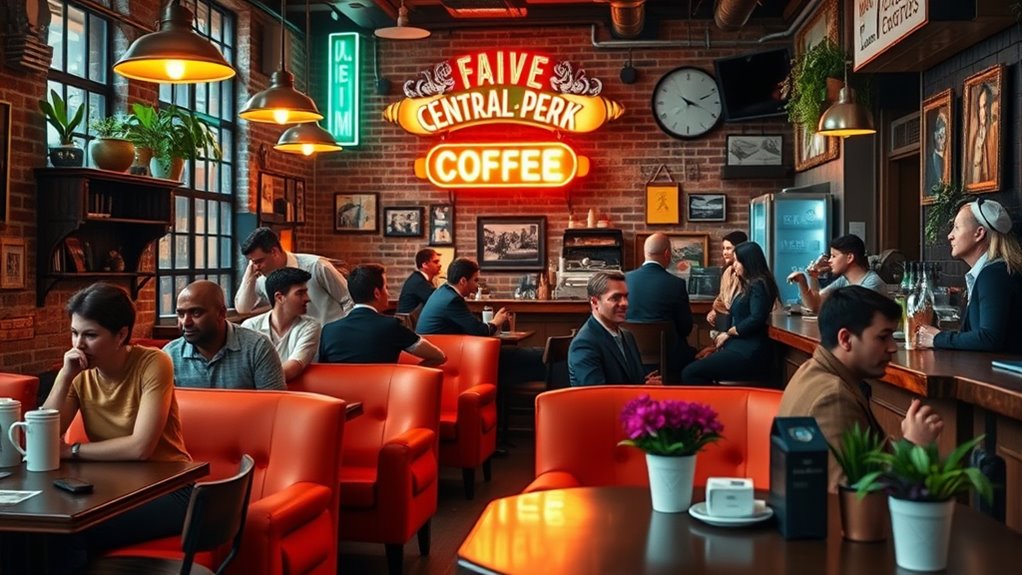Sitcoms show how third places like Central Perk or Cheers serve as essential social hubs outside home and work where you can connect and relax. These environments mirror societal shifts, with their decor and layout evolving to reflect character growth and community changes. As key backdrops, they influence interactions and foster bonds. If you keep exploring, you’ll see how these fictional spaces reveal much about social life, community, and the importance of adaptable social environments today.
Key Takeaways
- Sitcoms portray third places like Central Perk as vital social hubs fostering community and connection beyond home and work.
- The evolution of iconic settings reflects societal changes and character development over time.
- Environments in sitcoms influence character interactions, highlighting their role in shaping social dynamics.
- Settings act as “living spaces,” mirroring internal character growth and external relationships.
- Evolving sitcom environments emphasize the importance of adaptable social spaces in fostering community cohesion today.

Sitcoms have long served as more than just entertainment; they function as modern-day third places—social spaces outside of home and work where people gather, relax, and connect. In these shows, the setting often acts as a character itself, shaping interactions and reflecting societal changes. As you watch, you notice how character dynamics evolve alongside the setting, creating a rich tapestry of relationships that mirror real-life social spaces. Take Central Perk from Friends, for example. Its cozy, inviting atmosphere fosters casual conversations, allowing characters to develop authentic bonds. Over time, the café’s set design evolves subtly—adding new décor or changing lighting—to mirror shifts in the characters’ lives or broader cultural moments. This setting isn’t static; it adapts, reinforcing the idea that third places are dynamic environments that grow with their communities. Recognizing the importance of these social environments helps you understand how they influence both individual growth and community cohesion.
You see similar patterns in other sitcoms where the setting’s evolution underscores character development. In Cheers, the bar transforms from a simple watering hole to a communal hub, reflecting its role as a gathering spot where everyone’s stories intertwine. The bar’s layout, the décor, even the music choices shift across seasons, emphasizing the ongoing changes in its patrons’ lives. These modifications aren’t just aesthetic; they deepen your understanding of how characters interact and evolve. As the setting shifts, so do their relationships, highlighting how third places serve as catalysts for social and personal growth.
You also recognize how character dynamics influence the setting’s evolution. In sitcoms like How I Met Your Mother, the apartment or local bar often acts as a backdrop to key moments, but these spaces are carefully crafted to reflect the personalities within. When a character changes or faces new challenges, the environment adapts—perhaps through new furniture, altered lighting, or different background details. This interplay between characters and their environment demonstrates that third places aren’t static—they’re living spaces that mirror the internal and external transformations of those who frequent them. Understanding this relationship underscores the importance of environmental change as a reflection of personal development.
Ultimately, sitcoms show you that character dynamics and setting evolution are deeply interconnected. The way a space looks and feels influences how characters behave, and in turn, their evolving personalities shape the environment around them. These fictional third places remind you that real-world social spaces are similarly flexible and essential, serving as arenas where people forge connections, adapt to change, and find a sense of belonging. As sitcoms continue to depict these evolving environments, they underscore the timeless importance of third places in fostering community and social cohesion.
Frequently Asked Questions
How Did the Concept of the Third Place Originate Historically?
You might find it interesting that the concept of the third place originated from historical origins as social hubs outside of home and work. These spaces, like cafes and taverns, served as gathering spots fostering community interaction. Sociologist Ray Oldenburg popularized the idea in the 1980s, emphasizing their importance in creating vibrant, connected communities. Today, these social hubs continue to shape how people connect beyond their immediate circles.
What Are Modern Examples of Third Places Outside Sitcom Settings?
You can find modern third places outside sitcoms in coffee shops and co-working spaces. Coffee shops offer a relaxed environment where you can socialize or work, fostering community. Co-working spaces provide a professional yet communal setting, encouraging networking and collaboration. These places serve as modern third places by allowing you to connect with others outside your home and workplace, helping to build social bonds and a sense of belonging in today’s urban life.
How Do Third Places Influence Social Cohesion and Community Building?
Imagine stepping into a modern coffee shop or park, much like Central Perk in Friends. These third places boost social cohesion by strengthening community bonding and expanding social networks. They provide informal spaces where you can connect, share ideas, and build trust. By fostering face-to-face interactions outside home and work, you help create a resilient community where everyone feels more connected and supported.
Are There Cultural Differences in the Perception of Third Places?
Cultural perceptions shape how you view third places, with social norms influencing their acceptance and use. In some cultures, third places are essential for community bonding, while others may see them as less important or even intrusive. You might find that in collectivist societies, these spaces foster stronger social cohesion, whereas individualist cultures may prioritize privacy. Recognizing these differences helps you appreciate diverse ways communities connect and build trust.
How Have Digital Spaces Replaced Traditional Third Places in Recent Years?
Digital spaces have effectively replaced traditional third places by creating virtual communities and digital cafes where you can connect with others. You interact through social media, forums, or online gaming, making it easier to socialize beyond physical boundaries. These virtual communities offer a sense of belonging and casual conversation similar to coffee shops, but they’re accessible anytime and anywhere, transforming how you build social ties in today’s digital world.
Conclusion
So, after all this, it’s ironic how sitcoms created the perfect third place—your go-to escape—only to remind you that, in real life, those cozy spots are fading. Today, you chase virtual connections or fleeting moments, missing the genuine warmth once found in Central Perk or similar havens. Maybe the real lesson is that no screen can truly replace the comfort of shared laughter and conversations—something sitcoms unknowingly showed us we desperately need.









